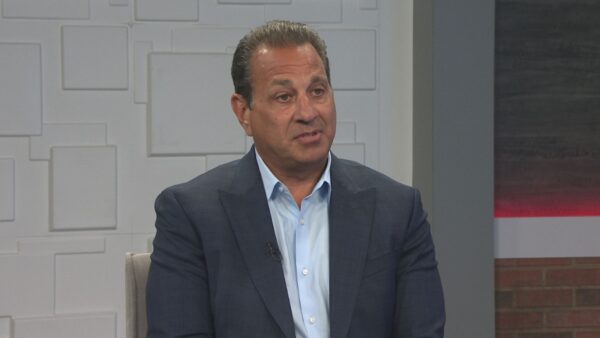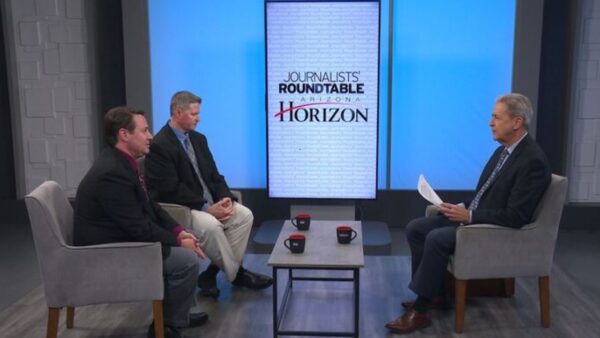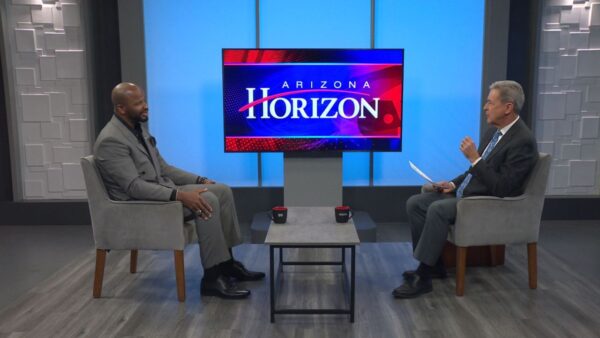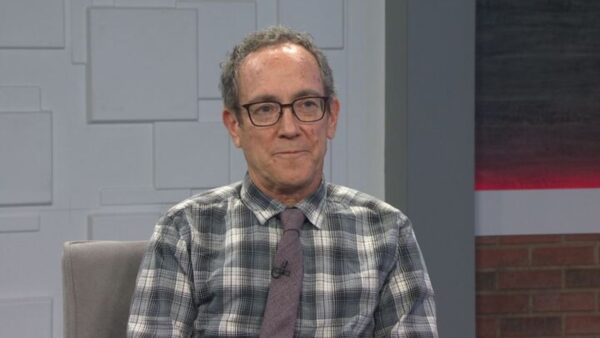senator Jay Tibshraeny (R) Chandler joins Horizon to talk about a bill he sponsored to license loan officers. The bill was passed by the legislature and signed into law by the Governor Napolitano. Tibshraeny also talks about the state budget in relation to the economy.
>>Ted Simons:
Tonight on "Horizon," mortgage brokers and originators will have to be licensed under a new law passed by the legislature and signed by the governor. And the monsoon is technically upon us. But where's the rain? We'll have a monsoon update next on "Horizon."
>>Announcer:
"Horizon" is made possible by contributions from the friends of Eight, members of your Arizona PBS station. Thank you.
>>Ted Simons:
Good evening, welcome to "Horizon." I'm Ted Simons. Loan originators are employed by a mortgage banker or broker and act as an intermediary between a lending entity and a consumer. A new law to license loan originators has been passed by the legislature and signed by Governor Napolitano. The law establishes a program with the Department of Financial Institutions to originators. It also details continuing education requirements for loan originators. Joining us is a sponsor of the bill to licensed originators is Senator Jay Tibshraeny. Thanks for joining us on the program.
>>Jay Tibshraeny:
Glad to be here.
>>Ted Simons:
Loan originator licensing bill, now law. What exactly does it do?
>>Jay Tibshraeny:
That bill, I modeled that after what they do in the real estate business, the salesperson, loan originator will now have to be licensed. He will have to, he or she will have to have a level of professionalism in the industry before they get their license and they will have to pass a proficiency exam of some sort. We haven't developed the exam yet. Once they have, they will be licensed, monitored by the Department of Financial Institutions. But they will have to take ongoing education, much like in the real estate industry, and their license will be under the guidance of the department and if there is problems with them or something, their license could be revoked. That is the most extreme thing. But, I think the main thing with that bill and -- is that it brings a level of professionalism to that industry. That industry needs that. There have been a lot of problems in the mortgage industry. Does this bill fix all of those problems? No. It is a very small segment, for a segment of that, the person issuing and talking with you and working with you on your loan will have to have that level of professionalism as he is advising you on probably the biggest investment that you or I will make in our lifetime. That is the person who gets all of your financial information, a lot of stuff that is secure and confidential and is dealing with that. So, the whole idea around this was just to raise that level of professionalism. This particular bill, I think the last time I was here in April, early April, I thought it was pretty much out the door and done. Things never go out the door and done real quick at the legislature. So, it got held up in the legislature as things do, and we had to work on that and work on that and work on that and then work on that a little bit more. And eventually, though, that bill got passed out of the legislature, I think, the last day or the second to the last day of the session.
>>Ted Simons:
And if I could talk about the machinations here in a minute-- regarding the bill how it got out and finally passed. Why weren't these particular folks licensed up until now?
>>Jay Tibshraeny:
I don't know why. Sometime in the state's history, real estate salesmen weren't licensed, but they weren't. The mortgage brokers, bankers were licensed, but that salesperson was not licensed. I don't know the reason. I don't have all of that history. I know in my few short years at the legislature, looking at it and talking to people, industry folks, they thought the time had come. When we hit the meltdown that provided the impetus to get the bill through. The bill or a bill similar to mine had been tried before in the legislature and was unable to get through. Last year it was tried, and I'm sure it was probably tried even before that. The time was right, probably because people were seeing what was going on in the industry, and although not all of that is because of the licensing issue, they said, yeah, we need it. The industry was very, very much behind us. I worked with industry groups before the session to develop a bill that people could feel fairly good about, and it handled the needs without going over the top. So, that's probably the impetus for it.
>>Ted Simons:
That being said, who was against this in the past, and who was against this go round?
>>Jay Tibshraeny:
Well, you had this go around, you had certain legislators for their own personal beliefs, which I respect, did not think licensing was needed or they may have thought that was too much government intrusion into this industry. But I think, as we have seen, I didn't think it was too much intrusion. In terms of the industry folks in the past who had opposed this, I'm not sure which ones were or weren't opposing it. I pretty much picked this up from last year on and decided that this was something I wanted to run with. Last year I worked and was able to successfully pass mortgage fraud legislation. I saw this when I was done with that last year, 2007, as kind of an extension and an addition to that effort to just raise the level of professionalism in the industry and to deal with that segment of what we're having to see.
>>Ted Simons:
Back to the fact that the bill was there for a long time, and couldn't seem to get a vote, and toward the end, it got a vote. There are some suggesting that in order to get that going, there had to be some sort of agreement on your part to go ahead with a pretty contentious budget. Was there some of that kind of business going on?
>>Jay Tibshraeny:
No, I never even had a discussion with the president of the senate about the budget and issues and this bill in particular in terms of trading anything. That is not the way I do things. This particular bill, I had to bring to the floor myself. That week, the last week of the session, we had a couple of issues that had gotten stuck in caucus for one reason or another. One was the Off-road Vehicle Bill. The second was the One Man-One Woman Marriage Amendment. Contentious issues and my bill was in there too as a contentious issue. Instead of going through caucus and having the president schedule those for hearings, that didn't happen. Monday, the Off-road Vehicle, they went around that process, and Thursday I went around that process. On Wednesday, went around that process also on the Marriage Amendment. Had to go kind of around that process to do it, but as a courtesy, you know, the president was aware that I was going to bring this to the floor for a vote. I felt that I had the votes to pass this legislation. I felt that way in April. But I wanted to wait and see could we get this through without having to go around the system and go through caucus and then have it scheduled in an ordinary manner. We couldn't and it got really crazy at the end of the session. It got really contentious. At this point talking with people very interested in the bill, they said if you are going to bring this to the floor and go around the process now is the time to do it and today is the day to do it.
>>Ted Simons:
You mentioned how crazy and contentious things got there toward the end. Obviously the budget was the 800 pound gorilla in every room. Last year you voted against the budget. This year you voted for a somewhat similar budget, why?
>>Jay Tibshraeny:
The budget may have been similar in some respects, but it was different in a lot of respects. Last year the budget that came out didn't really deal with the real numbers. It was basically passed out as a budget with 6% growth, when in reality, it had negative growth. This year we know that we're dealing with a deficit approaching $2 billion, 2.1, $2.2 billion, however that ends up going. We dealt with a deficit this year of $2 billion. And that would probably be the big difference, versus last year, actually showed growth in the state's revenues.
>>Ted Simons:
And yet lots of folks on the Republican side are simply not happy with this budget at all. I assume you are getting a little bit of heat on this --
>>Jay Tibshraeny:
Yeah I am getting it on both sides. Some people are really happy, some are not happy, that, to me, is a budget that probably found a decent medium. There is no budget when you have that kind of deficit that is going to get a lot of votes. It's impossible. When you are dealing with a $2 billion deficit, no matter which way you cut that pie, you will have a lot of people upset with that budget. When you look at a budget of $10.6 or 8 billion whatever it was a year ago and you are having to make 20% adjustments that is a significant adjustment. People are not going to generally be happy. I have been down there when we had surpluses of a billion and we did significant tax cuts which I've supported and pushed for-- those are easier times. People are more interested in spending money. I have never been a spender-here's my request to do this or that. That is not my thing; it is to have a nice sound budget. When you have a deficit that the level that this state has and we will probably have a tough budget year next year. People are not going to be happy and you are going to have a difficult time putting together a budget that everybody says this is great.
>>Ted Simons:
Special session likely in the near future?
>>Jay Tibshraeny:
Probably a need to adjust this budget based on where the state's economy is going. There may be, but also last year when I thought we should come in, we didn't, and they fixed it in April. I think a special session is good, but it is not good if we start with the same contentiousness that we ended with last year. If the contentiousness is still in the air, I think we can fix it in January. Either way, I'm comfortable with it.
>>Ted Simons:
Good to have you back on the program. Thanks for joining us.
>>Jay Tibshraeny:
Nice to be here.
>>>Ted Simons:
This is the time of year when people in the Phoenix metro area, and many other parts of Arizona, wait in anticipation of the Monsoon rains.
>>Ted Simons:
What do the numbers tell us about tracking the Monsoon and temperatures? Does the urban heat island affect rainfall availability across the Phoenix area? We will answer those and other questions in a moment. First a look at some Monsoon figures and a rainstorm we caught on tape last year at this time.
>> I remember rain. It brings back memories. Joining me now with more on the Monsoon is Tony Haffer, meteorologist in charge at the Phoenix office of the National Weather Service. Thanks for joining us.
>>Tony Haffer:
Pleasure to be here.
>>Ted Simons:
Let's start first with the change in the definition of when the Monsoon starts. Why did you have to go ahead and change that?
>>Tony Haffer:
Maybe because we're bureaucrats or maybe we're trying to simplify things. It was our opinion that over the years there was too much focus on whether we had three consecutive days of dew point at or above 55 degrees, and not so much on watching storms that could provide hazardous weather in a metro area. We parallel the hurricane season philosophy, that we pick dates that pretty well enveloped those years that we had Monsoon storms, June 15th through September 30th, so that it gives us an opportunity to ramp up, get ready for the storms and rethink our summer weather.
>>Ted Simons:
You know that it never seems like we have too much in the way of Monsoons here in the Valley before really the start of July.
>>Tony Haffer:
Yeah, that is certainly true. The other side of the coin, if you look at it from a statewide basis, the moisture is usually in the southeast part of the state and often in the distance we see thunder heads, and we wonder what's going on? Why aren't we getting our share of things? As time goes on, the moisture comes and we feel humidity like we are now and eventually the storms come. The whole process of bringing moisture, the shift of the wind from a more westerly direction to an easterly direction takes a little bit of time and we have kind of a dry phase of the Monsoon, we have the dry lighting that causes fire starts and what have you. Rather than focusing on the wet part, dew points, let's call it a season start June 15th and we can all pray for rain.
>>Ted Simons:
Are Monsoons changing over the years? I ask that as a long-time Arizonan. I think I see less in the way of Monsoon activity than I did ten, 20 years ago when it seemed like every afternoon something was going on?
>>Tony Haffer:
Yeah, I think it is maybe our memory as younger people, children, if you will; it seemed to rain every day whenever we wanted it to, that sort of thing. Statistics don't really bare that out. Nature of storms, particularly thunderstorms in Arizona, is that they're what we call air mass. They're kind of hit and miss. There are times when you are lucky enough to be under a storm and many times when you are not lucky enough. It is a matter of one's perception. And I tend to remember the favorable things of my past and rain would be one of them. Certainly it was wetter in my past, if only in my memory.
>>Ted Simons:
Even the build-ups are the same as they have always been. It seems like those things are hanging around out there by the Mogollon Rim and that's not coming in. It is the same?
>>Tony Haffer:
The process is the same, the hit and miss nature is the same, the expansive nature of the city is such that we may have changed locations closer to the mountains or further away from the mountains.
>>Ted Simons:
The theory is out there and true or false--We have to have a series of 110 to 115 degree days to draw the moisture up here? True or false?
>>Tony Haffer:
I think it is mostly true. If you think about it, hot air rises, and it has to be replaced by something. And it generally is replaced by something close to the surface. In the summertime, because there's not a strong wind flow, the more air that goes up vertically, the more opportunity that we have to bring air in from the south of us, which, of course, is where our moisture sources are. So, generally speaking, it takes the hot period before the moisture gets here to get the Monsoon or the wet part of it in full swing.
>>Ted Simons:
Does Global Warming affect that?
>>Tony Haffer:
Global Warming is certainly affecting the atmosphere. It is difficult to pinpoint any particular impact Global Warming has on a small region. I think what is happening over the course of time the atmosphere is warming up, making available more energy for storms to act on, but I don't think Global Warming, per se, is going to change how quickly or how slowly the moisture reaches us.
>>Ted Simons:
Let's talk for a moment about Urban Heat Island, for those not familiar with it; what is it and do we has it in the Valley?
>>Tony Haffer:
Do we have it? You bet. Urban Heat Island is a phenomenon fixed to the fact that we have buildings, concrete, streets with asphalt, absorb the sun's rays, retains the heat. Then overnight without the urban environment, the atmosphere cools, land is much nicer. But, when we have the urban environment, the heat that was retained in the streets and buildings actually slowly radiates out. So as the urban heat island effect increases, we notice our mornings are much more warm than they used to be, actually unbearable at times. We have been having mornings in the past years with a number of morning lows above 90. All of that pretty much is attributed to this thing we call an Urban Heat Island.
>>Ted Simons:
How does it affect the Monsoon?
>>Tony Haffer:
That is a good question. There is no indication that the Urban Heat Island per se is affecting the Monsoon. I think the effect is that it makes the mornings even worse. We have the moisture that is part of the Monsoon. If the heat is hotter than usual, it is more uncomfortable in the morning. In terms of generating or not generating storms, the Urban Heat Island doesn't play. In terms of making life miserable for you and me, it sure does.
>>Ted Simons:
As far as the Monsoon is concerned, why is it that some parts of the Valley get a lot more rain and certainly more in the way of clouds, wind, and dust than other parts of the Valley? It seems like the east side, it goes straight up and down the east side, a lot of storm activity. The west side, Buckeye, Gila Bend, they don't get much at all. Why?
>>Tony Haffer:
Didn't pay there rain taxes that's the problem. No-If you look at the way things develop in the summertime if you look to the north and to the east, the storms developing over the mountains. It's because air is being forced vertically, it has moisture in it, as the air moves vertically, holds less moisture clouds form. And eventually if there is enough vertical movement of the air, you can actually get showers. Well, if you think about it, in the summertime, we don't have a lot of wind. Those showers develop along the mountains and slowly edge their way toward the Valley. There is not a lot of support, if you will, behind them. So, if you are closer to the mountains, you are more prone to get rain, you are more prone to get more rain, and you're more prone to be happy in the summertime, as opposed to us who live down in the Valley, in the desert, hello, didn't get its name from the fact that it rains a lot. It is a matter of the process that goes on.
>>Ted Simons:
And yet memory suggests when you do get a storm out of the northwest or southwest or directly west, those things can be real doozys.
>>Tony Haffer:
Absolutely. The reason that they can be is that because the atmosphere prior to the storm's development is what we call to be more unstable, it is more supportive of vertical movement in the air, even without the mountains. So, if we get a storm brewing and coming into the Valley and it maintains itself in the western part of the Valley, there is a lot of mechanisms going on internal to the storm. The atmosphere is being very supportive. It is allowing the storms to continue, propagate all over the place and we get all sorts of rain and wind. When we have a less unstable part of the season, like we have been having the last few weeks or so, the storms come in, and there is not a lot of support and they just sort of die out.
>>Ted Simons:
Is that the same reason why it seems in Phoenix we always have a couple of, at least two if not more of these overnight rainstorms that seem to pop out of no where and wake everyone out of bed with this crazy lightning and thunder? Is it because the instability is so strong anything can happen?
>>Tony Haffer:
Absolutely. We at times kid in the weather office saying don't breathe vertically because the atmosphere is so unstable we might get a storm. You're absolutely right. Any disturbance in the atmosphere that might be moving off of the mountains in the middle of the night has the ability when the atmosphere is unstable and to generate a storm, and hence the nighttime thunderstorms.
>>Ted Simons:
We mention Phoenix has not seen much in the way of difference as far as the Monsoon is concerned. What about Tucson?
>>Tony Haffer:
Tucson is the lucky part of the state in that sense. They certainly have their share of moisture and their share of storms. They are much closer to the mountain so the Tucsonans have a lot more opportunity to enjoy rain than we Phoenicians. They are seeing no increase in the storms in terms of frequency and rainfall, but compared to us they get a better Monsoon rainfall.
>>Ted Simons:
We talked about the Urban Heat Island Effect. There is something called the Urban Oasis Effect, and you were mentioning how the Urban Heat Island means morning temperatures and the lows are getting higher, is it true some of the highs may be getting lower?
>>Tony Haffer:
It is an interesting phenomenon. If you think about it, there is a lot of things going on in an urban environment, at least in the case of the desert, that wouldn't be going on in a desert. For example, golf courses, we irrigate lawns, we have trees, we have green belts and the like-all of that is bringing moisture into a relatively condensed area. If you think about it, moisture tends to blanket the atmosphere and reduces the amount of sun that can reach the ground and warms us up. The bottom line is by bringing in man-made things like plants and pools and all sorts of waterfalls that we might have, it is bringing more moisture into our area and it is reducing the amount of sunshine, and, hence, lowering the temperatures just a little bit, not a lot, from what it would be in a natural desert.
>>Ted Simons:
Not lowering the highs as much as the lows are getting higher because of the Urban Heat Island?
>>Tony Haffer:
Absolutely correct. We are seeing a minuscule reduction of the high temperatures, maybe on the order of one to two degrees but more on the order of five to ten degrees in the morning.
>>Ted Simons:
There was a recent study that got a lot of attention, with Global Warming, we will see more in the way of spiked high temperatures in certain parts of the country. Whereas 122 still is the record here, 119 to 122 we could see on a somewhat regular basis in a decade, two, three, something along these lines. Do you buy into that at all?
>>Tony Haffer:
Well, I think the -- I can't talk about the numbers per se, but I can talk about the concept. The concept is there is more energy in the atmosphere, and when there is more energy in the atmosphere, the ability of the atmosphere to produce storms and things like that is greater. One of the things we might look at is the drought that has been causing the fires to be very, very vicious in California. If you think about the same type of thing in the atmosphere, the drought dries out all of the fuels. When you get a fire start, boom, you can have a tremendous issue with regard to a wildfire. Similar thing in the atmosphere. We have more warmth and a greater ability to dispense energy. So, I think what we're going to see is more intense rain events, hurricanes, maybe stronger with their winds, heavier rains. The temperatures, too, can be spiking as well because in between these rain events, there is a lapse where the atmosphere and the earth tries to stabilize so we can have more extreme heat waves as well.
>>Ted Simons:
So is it going to be a situation where in 10, 20, 30 years, are people going to be saying I have to get out of here because I can't -- our lows could literally never go below 100 degrees?
>>Tony Haffer:
That is one of the pools if you will, in the office. When is the first day we will forecast a low temperature of 100? That is a real possibility that the heat will be so oppressive that we as human beings will not enjoy living here as much as we might right now. Is it going to be 30 years from now? Probably on that order or more.
>>Ted Simons:
The Monsoon makes it very easy to live here especially in the summer. Let's hope it starts to get its act together.
>>Tony Haffer:
Absolutely.
>>Ted Simons:
Good to have you on the program. Thanks for joining us.
>>Tony Haffer:
My pleasure. Thank You.
>>Ted Simons:
Arizona has plenty of sunshine. What else does it need to become a leader in solar energy? State lawmakers cut funding for school vouchers. An update tomorrow at 7:00 on "Horizon."
>>Ted Simons:
Visit our web site azpbs.org/horizon for video and transcripts of this program and archived programs from the past. That is it for now. I'm Ted Simons. Thank you for joining us. Let's hope it rains and rains soon. You have a great evening. Captioning performed by lns captioning--www.lnscaptioning.com
>>Announcer:
If you have comments about "Horizon," contact us at the addresses listed on the screen. Your name and comments may be used on a future edition of "Horizon."
>>Announcer:
"Horizon" is made possible by contributions from the friends of eight, members of your Arizona PBS station. Thank you.
Jay Tibshraeny:State Senator;Tony Haffer:Meteorologist, Phoenix office, National Weather Service;




















